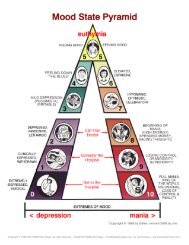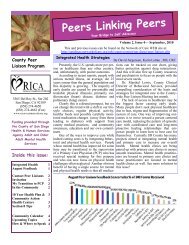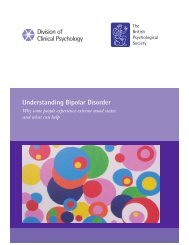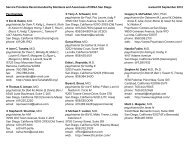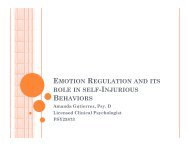Treating Emotion Dysregulation with Dialectical ... - DBSA San Diego
Treating Emotion Dysregulation with Dialectical ... - DBSA San Diego
Treating Emotion Dysregulation with Dialectical ... - DBSA San Diego
You also want an ePaper? Increase the reach of your titles
YUMPU automatically turns print PDFs into web optimized ePapers that Google loves.
<strong>Treating</strong> <strong>Emotion</strong> <strong>Dysregulation</strong><br />
<strong>with</strong> <strong>Dialectical</strong> Behavior Therapy<br />
Skills Training<br />
Milton Z. Brown, Ph.D.<br />
Alliant International University<br />
DBT Center of <strong>San</strong> <strong>Diego</strong><br />
www.dbtsandiego.com
DBT is a Treatment for<br />
Severe, Pervasive, and Chronic<br />
<strong>Emotion</strong> <strong>Dysregulation</strong><br />
(borderline personality disorder)
DBT is a Principle-Driven<br />
Treatment<br />
• all CBT strategies are utilized<br />
• minimal use of step-by-step protocols<br />
• flexible use of multiple strategies<br />
• function supersedes form<br />
• based on theory of BPD<br />
• based on behavioral analysis (theory of client)<br />
3
DBT Strategies<br />
• Individual therapy<br />
– weekly sessions (usually 60 minutes)<br />
– telephone skills coaching<br />
– telephone crisis management<br />
• Skill training (usually group of 5-10)<br />
– clients do not talk about self-injury or suicidal<br />
intent or behavior<br />
– very structured didactic format<br />
– not a process group
DBT Treatment Outcomes<br />
UW Replication Study<br />
• Effects of DBT are not simply due to:<br />
– session attendance<br />
– getting good therapy (TBE)<br />
– therapist commitment and confidence<br />
• Expert therapists are better than treatment<br />
as usual
DBT Treatment Outcomes<br />
DBT has better outcomes than TAU/TBE on:<br />
• suicidal behavior (self-injury)<br />
• psychiatric admissions and ER<br />
• treatment retention (25% vs. 60% dropouts)<br />
• angry behavior<br />
• global functioning<br />
All treatments show improvement on:<br />
• suicide ideation<br />
• depressed mood<br />
• trait anger
DBT Treatment Outcomes<br />
Linehan DBT Replication Study<br />
Tx Year FU Year<br />
DBT TBE DBT TBE<br />
Suicide Attempt 23% 47%<br />
Psych ER 43% 58% 23% 30%<br />
Psych Inpatient 20% 49% 23% 24%
DBT Interventions are based on<br />
Theory of BPD<br />
and<br />
Theories of Change
Development of BPD<br />
Linehan’s Biosocial Theory<br />
Biological and environmental factors account for BPD<br />
• BPD individuals are born <strong>with</strong> emotional vulnerability<br />
• BPD individuals grow up in invalidating environments<br />
• Reciprocal influences between biological vulnerabilities<br />
and an invalidating environment lead to a dysfunction in<br />
the emotion regulation system.<br />
• Mutual coercion (don’t let this pattern repeat!)
Development of BPD<br />
Linehan’s Biosocial Theory<br />
BPD individuals grow up in invalidating environments<br />
• their emotions/struggles get trivialized, disregarded,<br />
ignored, or punished (even when normal)<br />
• non-extreme efforts to get help get ignored<br />
• extreme communications/behaviors taken seriously<br />
• sexual abuse<br />
Why?<br />
• parents are cruel (invalidated or abused as children)<br />
• low empathy and skill: don’t understand child’s struggle<br />
and get frustrated and burned out
Development of BPD<br />
Linehan’s Biosocial Theory<br />
• BPD individuals learn to invalidate themselves<br />
– intolerant of their own emotions and struggles (punish,<br />
suppress, and judge their emotions, even when normal)<br />
• They easily “feel invalidated” by others<br />
• They still influence others via extreme behaviors<br />
– self-injury/suicidality to get help<br />
– aggression, self-injury, and suicidality to get others to<br />
back off
Most Good Treatments<br />
Don’t Work for BPD Patients<br />
BPD has been associated <strong>with</strong> worse outcomes<br />
in treatments of Axis I disorders such as…<br />
• Major depression<br />
• Anxiety disorders<br />
• Eating disorders<br />
• Substance abuse<br />
probably because BPD patients have low<br />
tolerance for change-focused treatments.
The Central Dialectic<br />
Acceptance and Change<br />
• BPD clients often feel invalidated when:<br />
– others focus on change (they feel blamed), but also<br />
insist that their pain ends NOW<br />
– others try to get them to tolerate and accept<br />
• BPD clients need to<br />
– build a better life and accept life as it is<br />
– feel better and tolerate emotions better<br />
• Only striving for change is doomed to fail<br />
– blocking emotions perpetuates suffering<br />
– disappointed when change is too slow<br />
13
The Central Treatment Dialectic<br />
Balancing Acceptance and Change<br />
• Balance therapist strategies<br />
– validation and Rogerian skills<br />
– CBT: problem-solving, skills, exposure, cognitive<br />
restructuring, contingency management<br />
• Balance coping skills<br />
– skills to change emotions and events<br />
– acceptance skills are necessary since not enough<br />
change occurs and not fast enough<br />
14
The Central Treatment Dialectic<br />
Acceptance and Change<br />
Soothing versus pushing the client<br />
Validation versus demanding
Theory of BPD<br />
• Numerous serious problems<br />
– suicidal behavior and nonsuicidal self-injury<br />
– multiple disorders<br />
– crisis-generating behaviors (self-sabotage)<br />
• Too many therapy-interfering behaviors<br />
– poor compliance and attendance<br />
– strong emotional reactions to therapists<br />
– therapist overwhelm, helplessness, and burnout<br />
– therapists judge/blame clients<br />
16
Theory of BPD<br />
Solutions:<br />
• Highly structured treatment<br />
– two modes: individual therapy and skills training<br />
• Clear target hierarchy – Most serious behaviors<br />
targeted immediately and directly<br />
– suicidal behavior and nonsuicidal self-injury<br />
– therapy-interfering behaviors<br />
– other serious problems<br />
• Stages of treatment<br />
– start <strong>with</strong> stabilization, structure, coping skills<br />
• Weekly therapist consultation meeting<br />
17
Theory of BPD<br />
Core Problem: <strong>Emotion</strong> <strong>Dysregulation</strong><br />
• pervasive problem <strong>with</strong> emotions<br />
• high sensitivity/reactivity (i.e., easily triggered)<br />
• high emotional intensity<br />
• slow recovery (return to baseline)<br />
• inability to change emotions<br />
• inability to tolerate emotions (emotion phobia)<br />
– vicious circle (upward spiral)<br />
– desperate attempts to escape emotions<br />
– vacillate between inhibition and intrusion<br />
– inhibited grieving<br />
– history of invalidation for emotions<br />
– self-invalidation and shame<br />
• inability to control behaviors (when emotional)<br />
18
Theory of BPD<br />
Core Problem: Avoidance<br />
• Denial of problems (avoiding feedback)<br />
• Non-assertiveness and social avoidance<br />
• Drug and alcohol abuse<br />
• Self-injury, suicide attempts , and suicide<br />
• Self-punishment, self-criticism (block emotions)<br />
• Dissociation and emotional numbing<br />
• Anger to block other (more painful) emotions<br />
• Anger to divert away from sensitive interactions<br />
• Hospitalization to escape stressful circumstances
Functions (overview):<br />
• Enhance capabilities<br />
• <strong>Emotion</strong> regulation*<br />
• Activate behavior<br />
contrary to emotions<br />
• Enhance motivation<br />
Principles of DBT<br />
• Structure environment<br />
• Assure generalization<br />
• Help therapists
Principles of DBT<br />
Functions (overview):<br />
• Enhance capabilities<br />
• <strong>Emotion</strong> regulation*<br />
• Activate behavior<br />
contrary to emotions<br />
• Enhance motivationMET<br />
• Structure environment<br />
• Assure generalization<br />
• Help therapists<br />
Skills Training<br />
Behavioral Activation<br />
Opposite Action<br />
Reinforcement<br />
Phone Coaching<br />
Consultation Meeting
Levels of Validation<br />
• Listen and pay attention<br />
• Show you understand<br />
– paraphrase what the client said<br />
– articulate the non-obvious (mind-reading)<br />
• Describe how their behaviors/emotions…<br />
– make sense given their past experiences<br />
– make sense given their thoughts/beliefs/biology<br />
– are normal or make sense now<br />
• Communicate that the client is capable/valid<br />
– actively “cheerlead”<br />
– don’t treat them like they’re “fragile” or a mental patient
Validation<br />
What (“yes, that’s true” “of course”)<br />
• <strong>Emotion</strong>al pain “makes sense”<br />
• Task difficulty “It IS hard”<br />
• Ultimate goals of the client<br />
• Sense of out-of-control (not choice)<br />
How<br />
• Verbal (explicit) validation<br />
• Implicit validation<br />
– acting as if the client makes sense<br />
– responsiveness (taking the client seriously)
Self-Validation<br />
Get the patient to say:<br />
“It makes perfect sense that I … because…”<br />
– it is normal or make sense now<br />
– of my past experiences<br />
– of the brain I was born <strong>with</strong><br />
– of my thoughts/beliefs<br />
Get the patient to act as if she makes sense:<br />
– non-ashamed, non-angry nonverbal behavior<br />
– confident tone of voice
Problem Solving<br />
Targeting<br />
Figuring out what to focus on:<br />
• Self-injury<br />
• Therapy-interfering behavior<br />
• <strong>Emotion</strong> regulation and skillful behavior<br />
– shame and self-invalidation (judgment)<br />
– anger and hostility (judgment)<br />
– dissociation and avoidance<br />
• In-session behavior
Understand the Problem<br />
Do detailed behavioral analyses to discover:<br />
– environmental trigger<br />
– key problem emotions (and thoughts)<br />
– what happened right before the start of the urge?<br />
– what problem did the behavior solve?<br />
and conceptualize the problem (i.e., identify factors<br />
that interfere <strong>with</strong> solving the problem)
Understand the Problem<br />
Identify factors that Interfere <strong>with</strong> solving the<br />
problem<br />
• Lack of ability for effective behavior<br />
• Effective behavior is not strong enough<br />
• Thoughts, emotions, or other stronger<br />
behaviors interfere <strong>with</strong> effective behavior
DBT Strategies<br />
Focus on <strong>Emotion</strong> Regulation<br />
• Reduce emotional reactivity/sensitivity<br />
– exercise, and balanced eating and sleep<br />
– exposure therapy<br />
• Reduce intensity of emotion episodes<br />
– heavy focus on distraction early on, which is a<br />
less destructive form of avoidance<br />
• Increase emotional tolerance<br />
– mindfulness<br />
– block avoidance<br />
• Act effectively despite emotional arousal<br />
29
<strong>Emotion</strong> Regulation Strategies<br />
• Validation/Acceptance (soothing)<br />
• Problem-solving<br />
• Skills training<br />
• Cognitive modification<br />
• Exposure and opposite action<br />
• Reinforcement principles<br />
– do not collude <strong>with</strong> avoidance<br />
– do not let avoidance pay off
<strong>Emotion</strong> Regulation Skills<br />
• Mindfulness<br />
• Distress Tolerance<br />
– surviving crises<br />
– accepting reality<br />
• <strong>Emotion</strong> Regulation<br />
– reduce vulnerability<br />
– reduce emotion episodes<br />
• Interpersonal Effectiveness<br />
– assertiveness
Skills for Reducing <strong>Emotion</strong>s<br />
• Distraction<br />
– activities <strong>with</strong> focused attention<br />
– self-soothing<br />
• Intense exercise<br />
• Relaxation<br />
– progressive muscle relaxation<br />
– slow diaphragmatic breathing<br />
– HRV biofeedback (BF)<br />
• Temperature<br />
TIPS<br />
– ice cubes in hands*<br />
– face in ice water, cold packs, whole body dunk (BF)
Skills for Reducing Behavior<br />
• Pros/Cons of new behavior<br />
• Mindfulness of current emotion/urge<br />
• Postpone behavior for a specific small amount<br />
of time (fully commit)<br />
– Distract, relax, or self-soothe<br />
– Postpone behavior again<br />
• Do the behavior in slow motion<br />
• Do the behavior in a very different way<br />
• Add a negative consequence for behavior
Skills for Increasing Behavior<br />
To get opposite action:<br />
• Pros/Cons of new behavior<br />
• Mindfulness of current emotion/urge<br />
• Break overwhelming tasks into small pieces<br />
and do first step<br />
– something always better than nothing<br />
• Problem solve; Build mastery
Relaxation Training<br />
• Progressive Muscle Relaxation<br />
• Slow breathing<br />
– breathe from the diaphragm<br />
– breathe at slow pace (resonant frequency)<br />
• about 5-6 breaths per minute (4 sec in, 6 sec out)<br />
– exhale longer than inhale<br />
– pursed lips<br />
– maximize HRV<br />
– biofeedback to maximize placebo effect
Relaxation Training<br />
Goals<br />
• Ability of patient to reduce emotional arousal<br />
when triggered<br />
• Reduce vulnerability to emotion triggers
Slow Breathing Training<br />
• Phase 1: breathe at resonant frequency (RF)<br />
• Phase 2: breathe at RF automously<br />
• Phase 3: quickly engage RF when distressed<br />
(during or immediately following emotion<br />
triggers)
Slow Breathing Training<br />
Problems<br />
• Patient cannot slow breathing enough<br />
– take a more gradual approach<br />
– take in more air<br />
• Patient gets light-headed or dizzy and stops slow<br />
breathing<br />
– take in less air<br />
• Patient breathes primarily from upper chest<br />
– lay down <strong>with</strong> book on abdomen<br />
• Patient cannot engage RF breathing <strong>with</strong>out prompts or<br />
heart rate feedback<br />
– much more practice (e.g., 20 min/day)<br />
• Patient cannot engage RFB when distressed<br />
– practice in context (e.g., during exposure therapy)



